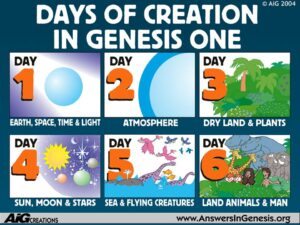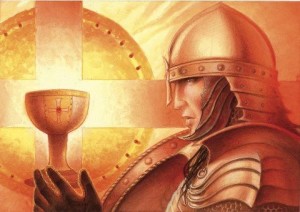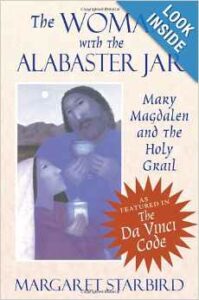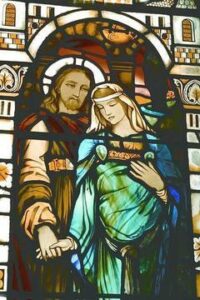 February 2, Candlemas, Imbolc, Feast of Purification February 2, Candlemas, Imbolc, Feast of Purification
You’ve probably heard of Midsummer and Midsummer Night’s Eve. Â But did you know today is Midwinter and last night was Midwinter Night’s Eve?
Midwinter, Groundhog Day and Candlemas are part of a very old holiday with a Christian-Pagan history. Its Christian version is called the Purification of the Virgin and is the end or culmination of the forty day period after Mary God-Bearer had her baby on December 25. Jesus is 40 days old today.  He gets to be Christened at the Temple, where Anna the Prophetess and Simon will see the baby and proclaim him the “Light of the World”.
In the ancient world, it was the custom for women to wait forty days after childbirth before entering a church or Temple again due to “uncleanliness”. This 40-day waiting period is still observed in Eastern Orthodox Christian churches today, and all Christian churches still schedule the Christening of a new baby at least forty days after the birth in keeping with this ancient purification practice. Also, there was the idea that the soul takes 40 days to anchor inside the baby.
Therefore today is Yeshua’s Christening or Naming Day when an exorcism is performed and the baby formally enters the Church.This special forty-day period in the Christian calendar is one of four such in the esoteric Church year.  The other three forty-day periods are:  Fall Equinox (Sept 21) to Halloween / AllSaints Day (Oct. 31, Nov.1), Spring Equinox (Mar 21) to May Day (May 1) and of course, Lent. Lent is the forty-day period beginning on Ash Wednesday and ending on Easter Sunday every year.Candlemas is a church “adaptation” of a pagan goddess holiday called Imbolc where people light candles to banish dark spooks. Candlemas is celebrated on the same day as that pagan holiday, February 2nd.
The word Imbolc, variously spelled Imbolg, Oimelc and Imelg, means “ewe-milk” because this is the time lambs were born in old England, Ireland and most of Europe thus bringing back the flow of ewe’s milk.
| February 1, Imbolc Today (tomorrow, according to some calendars) is the day of Candlemas, the Festival of Lights, a Midwinter Festival. Known to Neopagans and ancient Celts as Imbolc (Gaelic origin, “in milk” or ” in the belly”), a festival of the Maiden Goddess and a traditional time to bless agricultural implements (especially the Plow) and livestock. Neopagans celebrate the holiday with home blessings and lighting candles to welcome the coming of the light and the Goddess in Spring. In Ireland, the day is the festival of St. Bridget, a holdover from celebrations of the Celtic Goddess Brighid. Traditional “corn dollies“ and “Bridget’s crosses“ are fashioned from straw.
–Jennifer Emick |
|
Bishop Katia writes:
OUR OBSERVANCE
On February 2nd we ask that all members of our Church of the Way and Ekklesia Epignostika light a candle at their altar and carry it across the room to put in a window.  It’s a simple but powerful rite that acknowledges today as a holy day going back 5000 years. You may light more candles if you’d like, the more the better. See the picture below for how many candles Christian churches get ready for this day! |
|
Make a Crown of Lights for the Candlemas Queen
Another observance is to light several taper candles (seven is best) which are shaped into a crown, called the Crown of Lights worn by the Candlemas Queen.  See the very end of this page for description:  “A Crown of Lights is prepared for the Mother and left by the altar. Traditionally, the Crown should be of candles or tapers, which are lit during the ritual.”
 Rev. Francis X. Weiser, SJ writes: Rev. Francis X. Weiser, SJ writes:
The Poles have a beautiful legend that Mary, the Mother of God of the Blessed Thunder Candle (Matka Boska Gromniczna), watches on wintry nights around Candlemas, when hungry wolves are on rampage outside the sleeping village. With her thunder candle she wards off the ravenous pack and protects the peasants from all harm…
All over Europe Candlemas was considered one of the great days of weather forecasting. Popular belief claims that bad weather and cloudy skies on February 2 mean an early and prosperous summer. If the sun shines through the greater part of Candlemas Day, there will be at least 40 more days of cold and snow. This superstition is familiar to all in our famous story of the groundhog looking for his shadow on Candlemas Day.
Mark Raines writes:
Imbolc really is the beginning of Spring, despite the fact that there may
still be snow in some places and dreary skies almost everywhere! If you look closely, you will see that the snow is just a blanket covering the beauty of the Mother, which is about to shine through soon. You’ll see the first hints of Spring, if you’re really looking for them. In this spirit, Candlemas is celebrated. (Note: Candlemas is the Christianized name for Imbolc, but the two are used almost interchangeably by many earth-based groups such as Wiccans today. Groundhog Day is a secularized term, but it draws from a Pagan tradition. More on that in a minute)
Imbolc is closely associated with the Celtic-Irish goddess Brigid. Imbolc is sacred to Brigid because she is a goddess of fire, of poetry, and of healing, all things that go along
with the creative powers of the onset of spring. She is a powerful representation
of the Maiden Goddess, and she has been almost perfectly preserved for us
today by none other than the Roman Catholic Church. Rather than call her
demon and risk the displeasure of all Ireland, they canonized Brigid and
made her the patron saint of poetry and healing. This appeased the Irish,
who at the time probably saw the Catholic saints as being very similar to
gods.
There is one very well-known tradition of Imbolc, and that is the tradition
of the groundhog’s shadow predicting our weather. If a groundhog came out
of its hole and saw its shadow, that meant six more weeks of bad weather.
This tradition is still widely celebrated today. Another tradition is to
put a candle in your window on Imbolc Eve, representing the Eternal Flame
of the Maiden Goddess.
 Feast of the Purification Feast of the Purification
In Myth and Ritual in Christianity, Alan Watts says about the Feast of the Purification observed in Catholicism, and by Anglicans and Lutherans: “Finally, the rites of the Incarnation reach their climax with the Feast of the Purification on February 2nd, otherwise known as Candlemas. For at this time the Church blesses all the lights to be used in its ceremonies thruout the year, since it was at Christ’s Presentation at the Temple that Simeon called him “the Light to lighten the Gentiles, and to be the glory of thy people.”…As the choir chants…all the clergy and people assembled for Candlemas receive the blessed candles before the altar, and then go in procession with them around the church, singing: O daughter of Sion adorn thy bride-chamber and welcome Christ the King: greet Mary with an embrace, who is the gate of heaven, for it is she who bringeth the King of Glory, of the new light. … During the mass that follows, all hold their lighted candles during the chanting of the Gospel” and various other times in the ceremony.
FEBRUARY 2nd (Excerpt below Ret’d from http://www.fellowshipofisis.com/jc/jcfeb1.html Jan 31, 2004)
Greek: DEMETER and PERSEPHONE; The Lesser Eleusinian Mysteries, Second Day:
(for the first and third days of Feb., see the above link)
Roman: CERES and PROSERPINE; LUPA. (Mosheim, Eccl. Hist. Vol. Il. p. 51)
“the list of festivals for the whole Christian church was swelled by the
consecration of the day [February 2nd] of the holy virgin Mary, that the
people might not miss their Lupercalia, which they were accustomed to celebrate
in the month of February.” Note by Soames: “This was instituted in the reign
of Justinian, and fixed to the second of February . . The Latins called it
. . Candlemass; because many candles were then lighted up; as had been done
on the Lupercalia, the festival of Proserpine, whom her mother Ceres ‘searched
for with candles . . See Hospinian, de Fest. Christ, p. 52.
(Whistler, English Fist. p. 86) “the early Church instituted on February
2nd the Feast of Lights, blessed her candles, placed by the altar in sheaves,
and filled her basilicas with candleshine . . ‘Thus’, said the Pope, ‘what
was done before to the honour of Ceres, is now done to the honour of the
Virgin’. (Foot-note) Quoted by William Hone, The Every-Day Book, Vol. 1 Col.
202”.
JUNO FEBRUA, The Purifier. (Brewer, Dict.) “Candlemas Day. . It was the old
Roman custom of burning candles to the goddess Februa, mother of Mars, to
scare away evil spirits”.
Celtic: BRIGANTIA, BRIGHID. (Denning and Phillips, Magical Philosophy, Vol.
III. p. 166) “Brigid is the most widely powerful of the Celtic Goddesses.
She is the power of the new moon, of the spring of the year, and of the flowing
sea. In Ireland she is most famed, and in Britain she was Goddess of the
widespread tribe of the Brigantes. Her festival, from ancient times to the
present, is the second of February, the Celtic FireFestival of Imbolc . .
In Pagan times, her statue was annually washed in sea or lake to celebrate
her festival, being conveyed ceremonially overland, in a chariot or a boat;
in her associated with a ship – she may be compared to Isis (note: see March
5th). . Always with candles and with water do we greet her, the great
Moon-Mother, patroness of poetry and of all making and of the arts of
healing.”
 Click on the image on the right to read a modern pagan take on Imbolc/Candlemas. Click on the image on the right to read a modern pagan take on Imbolc/Candlemas.
(B. Morgan, Matriarchy Newsletter, No. 2) “Just as Hallowe’en marks the retreat into winter darkness and symbolises menstruation at the dark of the moon, so Candlemass marks the opening out of the natural world, ovulation, and emerges into the pure light of Spring first glimpsed at the Winter Solstice. The festivals symbolise on another level the Celtic belief in reincarnation; death at Hallowe’en followed by gestation in the dark space-womb of the Goddess and rebirth in a new body at Candlemass. This is the time for initiations in witchcraft, a rebirth of the spirit.
“Candlemass is when we come spiralling out again from the darkness, and our matriarchal symbol, the spiral, seems to recur in many aspects of Brigit’s cult. The dynamic shape of her crosses, the curling coats of her sheep and perhaps even the twisted patterns in Aran wool, handed down from mother to daughter, are part of her”.
British-Roman: SUL-MINERVA. (B. Morgan, id.) “Sul-Minerva of Bath seems to be identical with Brigid; a goddess of knowledge and healing with an ‘ashless fire’ in her sanctuary. If Sul, whose name derives from the Celtic words for the eye (i.e. suil) and seeing, is cognate with the Goddess of Silbury Hill, there could well have been a procession at Candlemass to her sacred spring, the Swellowhead, which begins to flow again in February, when the Queen ‘comes from the mound’ “.
English: THE WIVES. (Esther Harding, Woman’s Mysteries, p. 131) “In the north of England . . Candlemas used to be called The Wives Feast Day because it was regarded as a fertility festival”.
General: THE WITCHES, Great Sabbat. (Doreen Valiente, ABC of Witchcraft, p. 98) on Druidic links with Witchcraft: “the Great Sabbats of the witches are identical with the four great yearly festivals of the Druids in Celtic countries; namely Beltane (30th April), Lughnassadh (1st August), Samhain (31st October) and Imbolc or Oimelc (2nd February)”.
Jewish: THE VIRGIN MARY. (Esther Harding, Woman’s Myst. p. 130) “Another ancient festival of candles celebrated long ago for a moon goddess is now repeated on the same date, February the second, for the Virgin Mary, Moon of our Church. . This is the Festival of Candlemas. It corresponds in date and customs to the Celtic Holy Day of St. Bride or St. Brigit. St. Brigit is the Christianized form of the ancient Celtic goddess Bridgit or Brigentis, a triune moon goddess whose worship was at one time very widespread. On February the first, as today in the Catholic Church at the Festival of Candlemas, the new fire was kindled and blessed”.
(Whistler, English Fest. p. 87) An extract from an account written by a
prebendary of Durham, in 1628, of John Cosin, bishop’s chaplain, later Bishop
of Durham: ” ‘On Candlemas Day last past, Mr. Cozens, in renuing that . .
ceremonie of burning candles in honour of Our Ladye, busied himself from
two of the clocke in the afternoon till foure, in climbing long ladders to
stick up wax Candles in the said Cathedral Church. The number of all the
Candles burnt that evening was two hundred and twenty, besides sixteen torches:
sixty of those burning tapers and torches standing up, and near, the High
Altar . .’ ” (id.) “A writer to the Gentleman’s Magazine in 1790 noticed
at Ripon that ‘the Collegiate church was one continued blaze of light all
the afternoon, from an immense number of candles’. Today, in all Roman Catholic
churches, and in some Anglican ones, the feast of lights is remembered, and
there is much blessing and processing with tapers . . Snowdrops are ‘Mary’s
Tapers’ – ‘Candlemas Bells’. They are the day’s particular flower”.
THE CANDLEMAS QUEEN. (Farrar, Eight Sabbats, p. 66) “Imbolg, 2nd February
. . In Christian tradition, the Crown of Lights is often worn by a very young
girl, presumably to symbolize the extreme youth of the year”.
In an illustration shown by Dr. Margaret Murray (The God of the Witches,
p. 15) the Swedish Lucia-Queen is a girl wearing a crown of seven tapers
set in a circle.
THE TRIPLE GODDESS; THE IMBOLG MOTHER. (Farrar, Eight Sabbats, p. 66) “Imbolg
. . The Preparation:
“The High Priestess selects two women witches who, with herself, will represent
the Triple Goddess-Maid (Enchantment), Mother (Ripeness) and Crone (Wisdom)
– and allocates the three roles.
“A Crown of Lights is prepared for the Mother and left by the altar.
Traditionally, the Crown should be of candles or tapers, which are lit during
the ritual”.
Groundhog Day. (Druids Cal.) “February 2nd: Groundhog Day. ” (Fell. of Isis
Dir.) “February 2nd: Groundhog Day. Down to Earth for growth”. |
 **I wonder what new age will begin after this 7th Day evolution testing / perfection era is over. Esoteric Christianity teaches since the Greek Bible shows Jesus resurrected aka awakened on the 8th day, this caused the earliest Christians to worship on Sunday instead of the 7th Day Sabbath of the Jews. Sunday was not chosen because it was the first day, but because it is the day AFTER the 7th Day, the New Age “Eighth Day”. It was the day of awakening, of enlightenment, of evolution of consciousness.
**I wonder what new age will begin after this 7th Day evolution testing / perfection era is over. Esoteric Christianity teaches since the Greek Bible shows Jesus resurrected aka awakened on the 8th day, this caused the earliest Christians to worship on Sunday instead of the 7th Day Sabbath of the Jews. Sunday was not chosen because it was the first day, but because it is the day AFTER the 7th Day, the New Age “Eighth Day”. It was the day of awakening, of enlightenment, of evolution of consciousness.

 February 2, Candlemas, Imbolc, Feast of Purification
February 2, Candlemas, Imbolc, Feast of Purification
 Rev. Francis X. Weiser, SJ writes:
Rev. Francis X. Weiser, SJ writes: Feast of the Purification
Feast of the Purification

